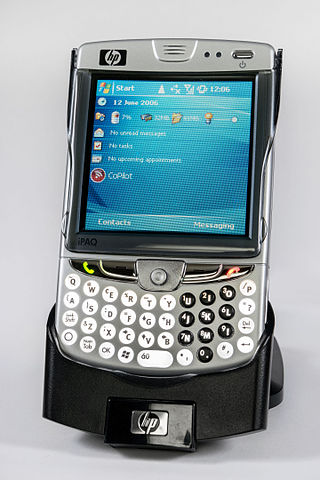
Compaq Computer Corporation was an American information technology company founded in 1982 that developed, sold, and supported computers and related products and services. Compaq produced some of the first IBM PC compatible computers, being the second company after Columbia Data Products to legally reverse engineer the BIOS of the IBM Personal Computer. It rose to become the largest supplier of PC systems during the 1990s before being overtaken by Dell in 2001. Struggling to keep up in the price wars against Dell, as well as with a risky acquisition of DEC, Compaq was acquired for US$25 billion by HP in 2002. The Compaq brand remained in use by HP for lower-end systems until 2013 when it was discontinued. Since 2013, the brand is currently licensed to third parties for use on electronics in Brazil and India.

The Intel 386, originally released as 80386 and later renamed i386, is a 32-bit microprocessor designed by Intel. The first pre-production samples of the 386 were released to select developers in 1985, while mass production commenced in 1986. The processor was a significant evolution in the x86 architecture, extending a long line of processors that stretched back to the Intel 8008. The 386 was the central processing unit (CPU) of many workstations and high-end personal computers of the time. The 386 began to fall out of public use starting with the release of the i486 processor in 1989, while in embedded systems the 386 remained in widespread use until Intel finally discontinued it in 2007.

A Pocket PC is a class of personal digital assistant (PDA) that runs the Windows Mobile or Windows Embedded Compact operating system that has some of the abilities of modern desktop PCs. The name was introduced by Microsoft in 2000 as a rebranding of the Palm-size PC category. Some of these devices also had integrated phone and data capabilities, which were called Pocket PC Phone Edition. Windows "Smartphone" is another Windows CE based platform for non-touch flip phones or dumber phones.

The iPAQ is a discontinued Pocket PC and personal digital assistant which was first unveiled by Compaq in April 2000.
Windows Embedded Compact, formerly Windows Embedded CE, Windows Powered and Windows CE, is a discontinued operating system developed by Microsoft for mobile and embedded devices. It was part of the Windows Embedded family and served as the foundation of several classes of devices including the Handheld PC, Pocket PC, Auto PC, Windows Mobile, Windows Phone 7 and others.

IBM Aptiva is a line of personal computers that was produced by IBM. It was designed primarily for home use and offered a range of models with varying specifications and features. It was introduced in September 1994 as the replacement for the IBM PS/1.

The TC1000 is a 10.4" laplet designed by Compaq, before it was purchased by HP. It used the Transmeta Crusoe processor. Unlike many other tablet PCs of its time, the display is fully detachable from the keyboard. The product was developed and manufactured using ODM model from LG Electronics, Inc. of South Korea.

Compaq's first computers' form factors were portable, also called "luggables", and then "lunchbox computers", and together constituted the Compaq Portable series. These computers measured approximately 16 inches (410 mm) deep, 8 inches (200 mm) tall, and approximately 20 inches (510 mm) wide. As the products evolved, laptops and notebooks were created offing a new level of portability that caused the market to explode.

Windows Mobile is a discontinued mobile operating system developed by Microsoft for smartphones and personal digital assistants.

The iPAQ Desktop Personal Computer in its various incarnations was a legacy-free PC produced by the Compaq Computer Corporation around the year 2000.

The Palm III is a personal digital assistant that was made by the Palm Computing division of 3Com. It went on sale in 1998 as a replacement for the PalmPilot handheld. It was the first Palm handheld to support infrared file transfer and a Flash ROM-capable operating system. At release, the Palm III was priced at US$400.

Subnotebook, also called ultraportable, superportable, or mini notebook, was a marketing term for laptop computers that are smaller and lighter than a typical notebook-sized laptop.

The Jornada was a line of personal digital assistants or PDAs manufactured by Hewlett-Packard. The Jornada was a broad product line that included Palm-Size PCs, Handheld PCs, and Pocket PCs. The first model was the 820, released in 1998, and the last was the 928 model in 2002 when Compaq and HP merged. The Jornada line was then succeeded by the more popular iPAQ model PDAs. All Jornada models ran Microsoft Operating Systems that were based on Windows CE.

The Compaq Evo is a series of business PCs and thin clients made by Compaq and then Hewlett-Packard following the 2002 merger. The Evo brand was introduced by Compaq in May 2001 as a business-oriented brand. It replaced the Deskpro brand of desktops and the Armada brand of notebooks. Evo was rebranded as HP Compaq which was used until 2008. It is not to be confused with the later Intel Evo branding for performant laptops.

The MobilePro is a discontinued line of personal digital assistants manufactured by NEC. Most models in the MobilePro range were handheld PCs with almost full size keyboards and a compact form placing them between being a palmtop and a subnotebook. All of the models in the MobilePro range ran a version of Microsoft's Windows CE mobile operating system and could be navigated using a stylus and touchscreen.

The Philips Velo was a Handheld PC.

The Contura was a line of notebook computers produced by Compaq. Released in 1992, the Contura was Compaq's first attempt at making an affordable, entry-level laptop computer.

A 2-in-1 laptop, also known as 2-in-1 PC, 2-in-1 tablet, laplet, tabtop, laptop tablet, or simply 2-in-1, is a portable computer that has features of both tablets and laptops.

HP Vectra was a line of business-oriented personal computers manufactured by Hewlett-Packard. It was introduced in October 1985 as HP's first IBM-compatible PC.

The LTE Lite was a series of notebook-sized laptops under the LTE line manufactured by Compaq from 1992 to 1994. The first entries in the series were Compaq's first computers after co-founder Rod Canion's ousting and Eckhard Pfeiffer's tenure as the new CEO. The notebooks were co-developed and manufactured by Compaq and Citizen Watch of Japan. They were a hot-seller for Compaq and spanned multiple models, with various processors and liquid-crystal display technologies.


















